The Archos 101 XS Review: Prettier, Faster, So Much Better
by Jason Inofuentes on August 22, 2012 12:15 PM ESTPeformance
Archos has backed off the "World's Fastest" claims of the marketing for the G9 Turbos for this campaign. If they'd made the claim again there’d be some evidence to suggest it wouldn’t be too far afield. We may not have had high hopes for the OMAP 4470 as a performance part, seeing it more as a place holder for Windows RT until an OMAP 5 part was ready, but it turns out it can be a bit of a scorcher.
At this point, we’ve covered OMAP 4 for what seems like an absurdly long time. Indeed, it’s been over a year since Brian published this, an architectural overview of the OMAP 4470 we’re looking at today. TI has long been a proponent of the idea of nestling a low-power core alongside a more powerful core, and we’ve actually seen this throughout the OMAP 4 series. Alongside each ARM Cortex-A9 core is a Cortex-M3 core, which provides a site for certain low level code to be processed without loading the A9s. TI sees this as a power savings opportunity. In OMAP 4470 they took this same idea and applied it to their GPU. Included alongside the SGX544 (a significant upgrade over the SGX540 that preceded it) is what they’ve dubbed their Composition GPU (CGPU). As the name implies, this lower power hardware is devoted to 2D composition, allowing the GPU to remain mostly idle when, say, you’re flipping through home screens. Here TI’s not just claiming a power savings, but also touting the ability of the CGPU to perform certain 2D operations faster than the GPU, netting a performance gain.
Archos has worked to tweak their Android build to perform as well as they could, and have leveraged all that TI’s silicon has to offer. Has all that hard work paid off?

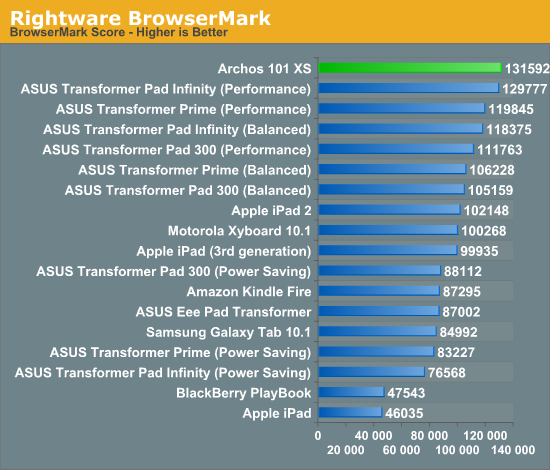
Browser performance is chart topping, beating both the new iPad and the lot of Tegra 3-equipped Transformers. I’ve always been a bit frustrated with browser performance test, their results on similar hardware have such a tendency to vary as to make me believe the results are contrived by the OEM. But that’s typically when a device bests the rest in a single benchmark, while it languishes in the other. That doesn’t seem to be the case here.
But what about that GPU? Let’s take a look at a chart so old, I can hardly bear it.
| Mobile SoC GPU Comparison | |||||||||||
| Adreno 225 | PowerVR SGX 540 | PowerVR SGX 544 | PowerVR SGX 543MP2 | Mali-400 MP4 | GeForce ULP | Kal-El GeForce | |||||
| SIMD Name | - | USSE | USSE2 | USSE2 | Core | Core | Core | ||||
| # of SIMDs | 8 | 4 | 4 | 8 | 4 + 1 | 8 | 12 | ||||
| MADs per SIMD | 4 | 2 | 4 | 4 | 4 / 2 | 1 | 1 | ||||
| Total MADs | 32 | 8 | 16 | 32 | 18 | 8 | 12 | ||||
| GFLOPS @ 200MHz | 12.8 GFLOPS | 3.2 GFLOPS | 6.4 GFLOPS | 12.8 GFLOPS | 7.2 GFLOPS | 3.2 GFLOPS | 4.8 GFLOPS | ||||
| GFLOPS @ 300MHz | 19.2 GFLOPS | 4.8 GFLOPS | 9.6 GFLOPS | 19.2 GFLOPS | 10.8 GFLOPS | 4.8 GFLOPS | 7.2 GFLOPS | ||||
The SGX544 is effectively half of the GPU we saw in the iPad 2, the only difference between the SGX543 and 544 being Direct X designations. GPU clocks in the iPad 2 were far more conservative, though, than the 384 MHz we see in OMAP 4470. When Brian looked over TI’s claims he found some rationale for their claim that their SGX544 performance would be 2.5x the SGX540 it replaces. As it turns out, that’s almost exactly the case in some of our tests.
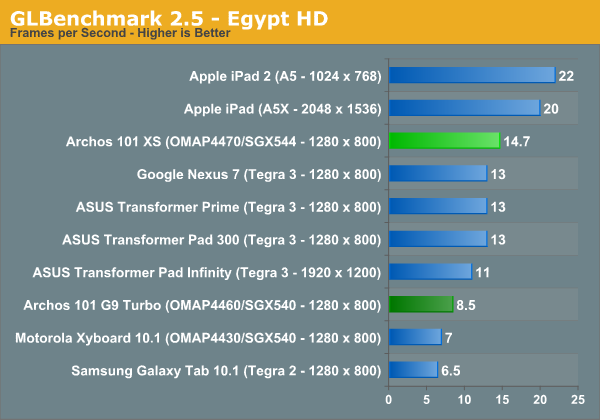

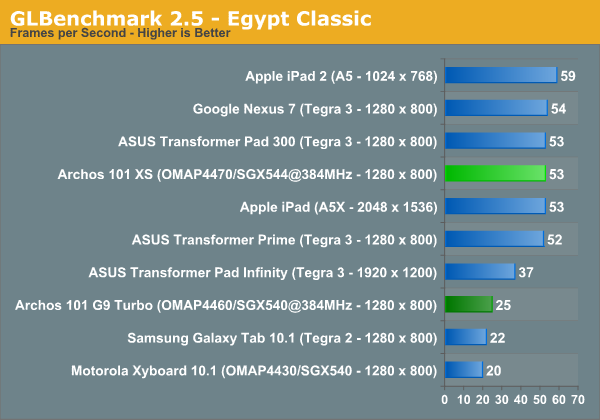
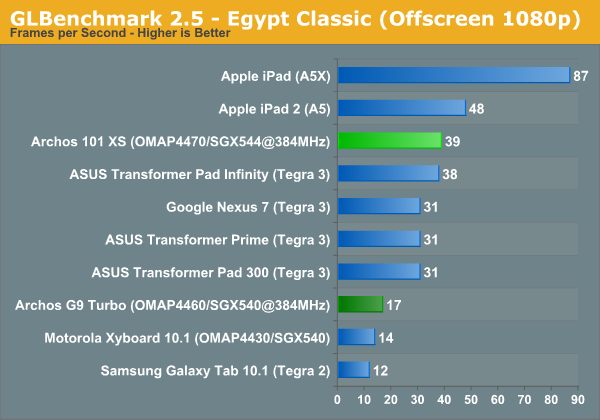
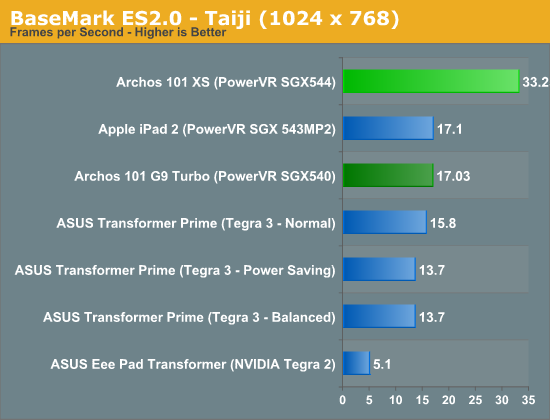
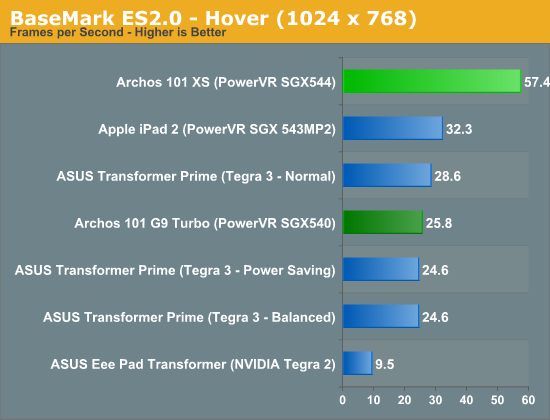
Where the G9s weren’t able to rise above the pack in some of our tougher GPU tests, the XS stays firmly planted at or near the top of all of our GPU tests. And despite being a single core to the iPad 2’s dual core GPU the ~12.3 GFLOPS bestowed on this SGX544 keeps it competitive with the iPad 2, particularly in the off-screen tests.
When Apple debuted the A5 they set the mold for future mobile SoCs, where a big GPU, complimented by hardware accelerated UI composition, would be integral to a great user experience. Samsung seemed to have picked up on this idea, packing the impressive Mali-400 MP4 into its Exynos 4xxx offerings. Qualcomm and TI have been a little later to this game, ramping up clockspeeds and doing some minor architectural tweaks to eke out as much performance as they could out of their last gen GPU architectures, Adreno 2xx and SGX54x, respectively. The good news is that each has been able to get quite a lot out of these older parts; the bad news is that a lot more power is right around the corner. So while the XS GPU performance is chart topping, that status is likely to be short-lived. But does it really matter?
Within the PC space the Atom and Core 2 era of processors defined a ‘good enough’ standard that persists somewhat to this day. While there are certainly performance and feature gains in a modern Core i5 to justify upgrading from a Core 2 era CPU, for the vast majority of users, a decent Core 2 will be enough; and some may even do fine with an Atom based system. We seem to be reaching this inflection point in the tablet space. The real world difference between two given Android devices has more to do with the software than the actual hardware inside. If you don’t believe me, go find an International SGS III variant, with Samsung’s cutting edge and stonking Exnos 4 Quad inside, and compare it alongside a Galaxy Nexus running Jelly Bean. The latest edition of Android pushes the relatively modestly powered Nexus well past the quad-core SGS III where it matters most, smooth UI performance. And while the beefier GPU and extra cores may help the Exynos 4 Quad when resolutions climb past 720p, it’s memory bandwidth that’s the real bottle neck there today, so the advantage won’t be fully realized until Android sees a SoC that focuses on that issue, a la Apple’s A5X.
What Archos has done is, I believe, set the bar past ‘good enough,’ and planted it firmly in the performance realm. Truth be told, we weren’t expecting much from the OMAP 4470; it just felt antiquated by technology standards. But solid hardware and a focused approach in software to draw out as much performance as the silicon would allow has very nearly won the 101 XS the title of World's Fastest. It's certainly far in excess of our expectations.


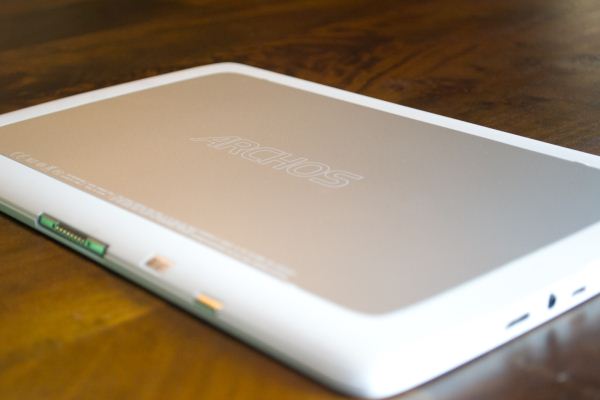








44 Comments
View All Comments
rwei - Wednesday, August 22, 2012 - link
...wait, what? But iOS didn't exist yet, how could there be rumors of it being used on a tablet? Or do you just mean an Apple tablet in general?JasonInofuentes - Thursday, August 23, 2012 - link
Fair enough, though, most likely, iOS did exist; we just didn't know about it yet.wsjudd - Wednesday, August 22, 2012 - link
Pedantic mode on:The weights in the first table have varying units and spacing (or, for the first one, no units at all).
Weight 600 635g 580.6g 340 g
JasonInofuentes - Thursday, August 23, 2012 - link
Fixed. Thanks.Cheers.
Jason
vthl - Wednesday, August 22, 2012 - link
it feels a little biased and intentional sometimes ..... certain devices always left out of the charts for no reason...... earlier it was macbook pro retina from the samsung Samsung Series 7 notebook in display comparison now nexus 7 etc has been from few comparison lists (but not all).... if you people haven't tested those products in any of the benchmark you are comparing with .... care to put a note in the chart itself (not tested) .JasonInofuentes - Thursday, August 23, 2012 - link
So, a lot of this has to do with the fact that, though we have standard ways of running tests, we don't necessarily have a standard series of tests we perform on all devices. Some of that has to do with time or other resources, some of that has to do with value. Some tests are only pertinent if the value deviates in anyway from expectations. Take, for instance, Anand's recent analysis of IO performance in tablets. Previously, we wouldn't have though to check. As it became an issue, with SoC performance and software putting a higher load on IO, Anand took to analyzing the issue. Given the value focus of the Archos lines, I expect that IO performance won't be groundbreaking. And that might matter. So, I'll look into it, but that involves coordinating with Anand to ensure my testing methodology matches his.And yes, we don't test every device. I'm going to reveal a secret to you all. We're not a large team, all sitting together in a technology playroom, testing devices from sun up till . . . well, sun up. For only a few of us is this our full-time job, and for the rest, we do our best to ensure that the most interesting things make it to the site. And sometimes, we never get chance to find out.
Feel free to let us know when you want to take a closer look at a particular comparison and we'll try and put it together for you. Thanks for reading.
Jason
Wwhat - Wednesday, August 22, 2012 - link
Is it me or does this several page article omit to name its sensors? A small spec list with such things might be appropriate with reviews (even if they are advertisement ones)And while I'm posting: I also was surprised to see how light the nexus is compared to the other tablets, that makes a huge difference I think.
JasonInofuentes - Thursday, August 23, 2012 - link
Lightness is a big plus for one-handed operation of a tablet, and I think it's a component in the growing popularity of smaller tablets. A 1.3 lbs device is fine sitting on my couch, but if I'm standing in a subway car, or playing a game, my arm's can get a little weary. I'd much prefer a lighter device then.As to your other comments, we take all our reader comments into account (even if they are unnecessarily snarky), so I'll try to do better. In this case, the only thing omitted from the usual set of radios is the light sensor.
xaueious - Wednesday, August 22, 2012 - link
I wouldn't be so quick to give Archos any credit for optimizing the browser performance. TI OMAP4 always had an edge in the Sunspider benchmarks, and the performance here is inline with those results. It was TI that did any of the work, not Archos. To be precise, the TI OMAP4 reference was optimized targeting the Galaxy Nexus to begin with, so there's nothing to see here.The ASUS Transformer TF300 with Android 4.1.1 scores 1343.5 ms in the stock browser. Jellybean really changes the landscape of the browser benchmarks. I don't think ICS utilizes Tegra 3 fully.
JasonInofuentes - Thursday, August 23, 2012 - link
This is actually a story we've been trying to tell for sometime. While OEMs take the credit, silicon vendors are often doing the heavy lifting with software performance. As often as not, though, the optimizations that a TI or Qualcomm build into the Android versions shipped to OEMs are left out, in favor of aesthetically or function tweaked browsers, widgets and app drawers. So, while I agree TI merits a lot of the praise here, we like to encourage OEMs to follow Archos lead, so we'll give them some love, too. That said, Archos didn't just take a build and run it. The OEM sets the governor, and finalizes clock speeds, and also decides whether or not to use a particular silicon feature, and in which way. In this case, Archos made changes to the way that instructions are guided towards the low-power cores, GPU and CGPU; their goal being a boost to performance compared to a more conservative stock build.And then there's Jelly Bean. As always, we test as quickly and as much as possible. The TF300 just got its Jelly Bean build this week, and the delta between its JB Sunspider score and the ICS one is massive. So, who's to say that the Archos JB build won't also break new ground? In which case, the TF300 with 4.1.1 serves mainly to demonstrate what's to come. But doesn't negate the performance of the OMAP 4470.
Thanks for the comments. Keep them coming.
Jason